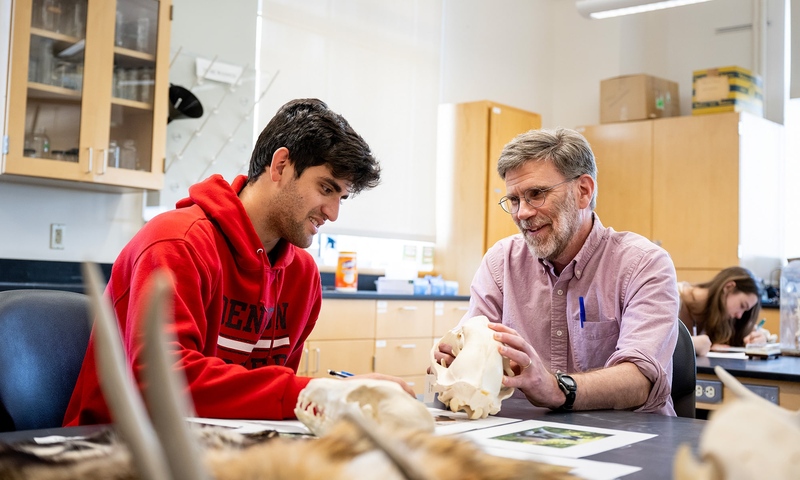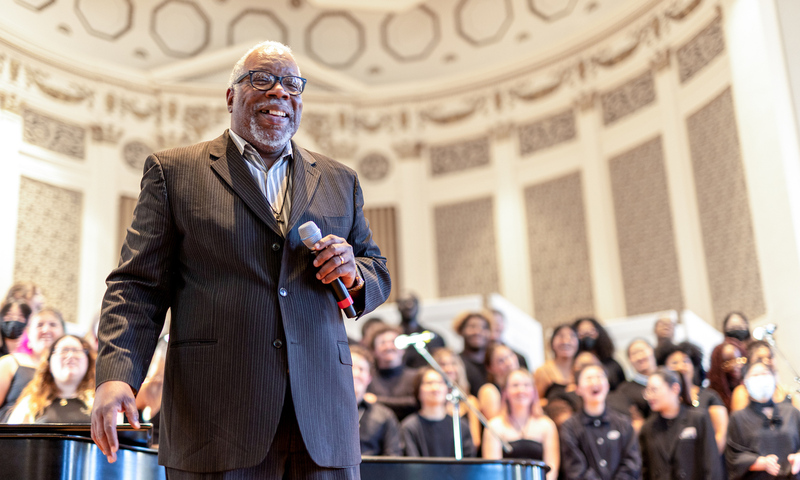This is the story of an unassuming and beloved Denison professor emeritus who probably wouldn’t call himself a war hero, but we will.
Born and raised in the Pittsburgh area, Andrew Sterrett graduated from high school in 1942 with the nation in the midst of war. He started college at the University of Pittsburgh and joined the Army ROTC. By June of 1943, however, the 19-year-old Sterrett was called to active duty and underwent basic training at Fort Riley in Kansas. Acknowledging his academic skills, the Army assigned him to attend classes at the University of Nebraska under the Army Service Training Program. This only lasted six months until he was called to serve with the newly formed 44th Infantry Division.
Sterrett and several other college students received a fair amount of razzing from the mostly older men in the 44th, which was largely made up of New York and New Jersey National Guard units. Since the college boys were being introduced into the unit “to raise the collective IQ,” recalls Sterett, kitchen duty was a good place to put their smarts to good use.
Soon after the Allies’ D-Day invasion of Normandy, the 44th shipped out of Boston for the front lines in France. Despite the looming threat of being torpedoed by German U-boats, the voyage was largely uneventful, though Sterrett did run afoul of military discipline when it was discovered that he and a friend were using the ship library instead of returning to their berths after meals as required. Their “punishment” was to perform “topside duty.” This, however, proved to be more of a benefit, says Sterrett, as they were able watch shipboard operations and the disembarkation at Cherbourg, France.
After several more weeks of preparation and training, the 44th Division was sent to face the German foe.
“It’s not what you lost, but what you have left, and how you use it.”
And so it was that on a chilly November day in 1944 near the French town of Luneville in the Lorraine region of eastern France, the 20-year-old Sterrett found himself on the front line occupying a damp foxhole with his friend Dwight Larsen. During his first days on the line, the enemy threat was more psychological, as German loudspeakers blared with propaganda messages designed to unnerve the new American soldiers. Sterrett recalls individuals who self-inflicted wounds to escape the stress. After several days, the battle commenced in deadly earnest.
One day, after completing sentry duty in his foxhole, Sterrett left to get some rations. Without warning, the Germans began shelling the American position, and he was caught out in the open. As he was trying to make his way to cover, a shell exploded near him, almost severing his left arm, badly shattering his right, and causing multiple shrapnel lacerations to both his legs and his spleen.
He remembers little after being hit. Moved by his comrades to relative safety, Sterrett spent the night in an unheated earthen bunker with a medic feverishly staunching the blood loss and trying to keep him alive with only the most basic of medical supplies. The following day, he was evacuated to a medical facility in an ambulance. He regained full consciousness days later to find himself in a body cast. He first became aware of the extent of his injuries when a Red Cross volunteer offered to write a letter home for him since he had lost his arm.
For Sterrett, the shooting war had ended. A second war — to survive, recover, overcome his physical difficulties, and achieve his life dreams — had just begun.
After two more hospital stays and one more surgery, Sterrett finally was shipped back home, arriving at the New York City harbor on January 5, 1945. He promptly took in a Rockettes show at the Radio City Music Hall, ordered a steak dinner at the noted Schraft’s Restaurant, and drank a much longed-for milkshake.
Sterrett was assigned to a medical facility outside Battle Creek, Mich. that specialized in working with amputees. He recalls feeling “lucky” because most of the others there had lost their legs. With the recent advances in leg prosthetics, though, he began to wonder if that assessment might have been premature. The facility focused on fitting functional prosthetics and teaching wounded servicemen how to perform basic functions, such as tying shoes and getting dressed.
Mental health counseling was not part of the treatment regimen — individuals were expected to get on with their lives once discharged. According to Sterrett, the prevailing theory was: “It’s not what you lost, but what you have left, and how you use it.”
Sterrett used it well. After his discharge, he returned home and enrolled in engineering classes at Carnegie Mellon University. He graduated, then he pursued graduate-level work at Pitt as a teaching assistant. There he met his future wife, Betts, at a trolley stop, where their conversation was spurred by the trademark grey glove he wore on his wooden hand.
Undeterred by the difficulties of adjusting to his war wounds, he obtained his first full-time college teaching position at Ohio University. In 1953, he was selected for a mathematics faculty position at Denison and began his 26-year teaching career in Granville. Highly regarded by students and staff alike, his keen intellect and easy humor made him something of an institution at Denison. In addition to serving as the chair of the mathematics department, he also was the dean of the college before his retirement from active teaching in 1989.
Sterrett has been awarded the French Legion d’ Honneur (Legion of Honor), for his valor and sacrifice in France during the war. We join the country of France in thanking Professor Sterrett of his courage and service to the country.
To read more: newarkadvocate.com







